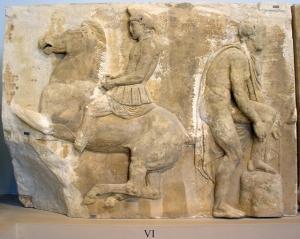The Acropolis Parthenon Marbles
 When the Parthenon was built between 447BC and 432BC, three sets of sculptures, the metopes, the frieze and the pediments, were created to adorn it. Of these, the metopes and the frieze were part of the structure of the Parthenon itself. They were not carved first and then put in place, high up on the Parthenon, but were carved on the sides of the Parthenon itself after it had been constructed. When the Parthenon was built between 447BC and 432BC, three sets of sculptures, the metopes, the frieze and the pediments, were created to adorn it. Of these, the metopes and the frieze were part of the structure of the Parthenon itself. They were not carved first and then put in place, high up on the Parthenon, but were carved on the sides of the Parthenon itself after it had been constructed.
The metopes were individual sculptures in high relief. There were 92 metopes, 32 on each side and 14 at each end, and each metope was separated from its neighbors by a simple architectural decoration called a triglyph. The metopes were placed around the building, above the outside row of columns, and showed various mythical battles. The north side showed scenes from the Trojan war; the south side showed a battle between the Greeks and the Centaurs - part man, part horse; the east side showed the Olympian gods fighting giants, and the west side showed a battle between the Greeks and the Amazons.
The frieze, 160 meters long, was placed above the inner row of columns, so it was not so prominently displayed. It is one long, continuous sculpture in low relief, showing the procession to the temple at the Panathenaic festival.
At either end of the temple, in the large triangular space, the pediment statues in the round were placed. These were designed to fill the space so that those at the highest point of the triangle are enormous. The pediment sculptures have been so badly damaged that we only know what they represent because of the writings of the Greek writer and traveller Pausanias, who was active around 150 AD. According to him, the sculptures in the east pediment represent the birth of Athena from the head of Zeus, and the sculptures in the west pediment represent the struggle between Athena and Poseidon for the land of Attica.
The real glory of the temple, however, was housed inside. The statue of the goddess Athena was about 40 feet (12 meters) high, and gold and ivory was used to decorate it. This statue was damaged by fire as early as 200BC, and it is thought that a new statue replaced it in 165-160BC. Unlike the Parthenon Marbles, the statue did not survive antiquity.
Not all of the Parthenon Marbles, however, survive down to the present day. There were originally 115 panels in the frieze. Of these, ninety-four still exist, either intact or broken. Thirty six are in Athens, fifty-six are in the British Museum, and one is in the Louvre. Of the original ninety-two metopes, thirty-nine are in Athens and fifteen are in London. Seventeen pedimental statues, including a caryatid and a column from the Erechtheion are also in the British Museum. So the Parthenon Marbles are almost equally divided - half in London and half in Athens.
It is precisely because the surviving sculptures are to be found in two countries 1500 miles apart that the Greek government has requested the return of the Parthenon Marbles from the British Museum so that they can be reunited in one collection, in a museum which has been built at the foot of the Acropolis Hill on which the remains of the Parthenon temple stand.
(text from www.greece.org) |
|



